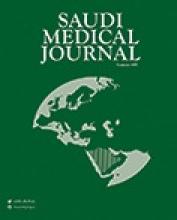SYSTEMATIC REVIEW ARTICLE
Epidemiology of Brucellosis in Saudi Arabia
Al Anazi et al investigated the epidemiology, etiology, distribution, impact, or burden of Brucellosis in the Saudi population. There were 17 studies that were conducted in diverse geographical areas of Saudi Arabia. Brucellosis incidence and prevalence vary widely among regions. Contact with infected animals and consumption of raw milk and milk products were identified as the main risk associated factors of brucellosis. Abortion and intrauterine fetal deaths rates were significantly higher among pregnant women with brucellosis compared with pregnant women without brucellosis. They study results revealed that brucellosis is a risk factor for adverse reproductive outcomes.
Flow chart of the literature review search
see page 981
ORIGINAL ARTICLES
Isolation and desolation of patients admitted with presumptive pulmonary tuberculosis. Can it be shortened?
Elzein et al investigated an ideal number of sputum acid-fast bacilli (AFB) smears and polymerase chain reaction (PCR) among patients with suspected pulmonary tuberculosis. Only the rst 3 sputum smears for AFB were included in the analysis. The PCR results for Mycobacterium tuberculosis (MTB) were also included in the study. Overall, 240 patients were MTB-culture positive. A total of 126 patients were smear and culture positive, whereas 114 were culture positive but smear negative. Of 126 patients who were AFB smear positive, 98 were detected in the first specimen, 13 in the second specimen, and only 9 in the third specimen. Polymerase chain reaction for MTB was positive in 122 smear-positive patients. A single Xpert MTB/resistance to rifampicin test detected all smear-positive patients, whereas the third smear did not significantly contribute to MTB isolation.
Sensitivities of acid-fast bacilli smear and polymerase chain reaction using culture as gold standard
see page 1008
CASE SERIES
Pancreatic tuberculosis in immunocompetent patients. At the University Hospital in Kingdom of Saudi Arabia
Alsaif et al confirmed that the fine needle aspiration and endoscopic ultrasound are good tools to confirm malignancy and rule out benign treatable conditions like tuberculosis for any patient with a pancreatic mass suspicious for carcinoma. The data were obtained based on demographic features, sign and symptoms, duration of illness, imaging, ultrasound, contrast enhanced computed tomography scan, cytology or histopathology, polymerase chain reaction, culture and follow up with anti-tuberculous therapy and samples for cytology or histology. A retrospective study at King Khaled University Hospital, Riyadh, Saudi Arabia of all patient charts presented with pancreatic mass for a period of 10 years with a study duration of 4 years.
The before computed tomography of case 9 with hypodense matted lymphadenopathy tuberculosis
see page 1052
CASE REPORT
Limb lengthening with one Precice nail over its capacity
Zakkiriah & Karakoyub presented a 37-year-old female patient with a 14 cm limb length discrepancy that was treated with a new surgical technique using the shortening feature of the Precice nail. Following maximum possible lengthening using the nail and without waiting for union on the osteotomy line, the distal interlocking screws were removed, and the nail was shortened by external remote control with the help of the fixator. The distal interlocking screws were then reattached to continue lengthening. This surgical technique can be used safely and satisfactorily in cases with more shortness as we can correct the extremity length discrepancy using only one nail.
The preoperative view of the patient
see page 1058
- Copyright: © Saudi Medical Journal
This is an open-access article distributed under the terms of the Creative Commons Attribution-Noncommercial-Share Alike 3.0 Unported, which permits unrestricted use, distribution, and reproduction in any medium, provided the original work is properly cited.










